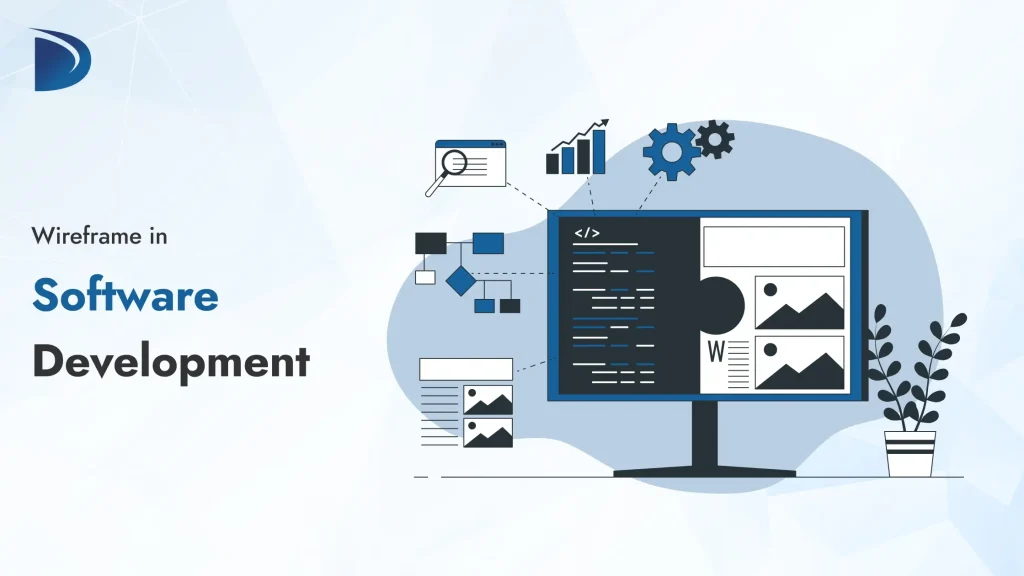Table of Contents
A wireframe is a collaborative visual plan that shows how a website or app will look and work. Think of it as a blueprint for a house, outlining the structure before adding colors, furniture, or decorations. In software development, wireframes are a team effort that helps plan the layout, navigation, and functionality of a digital product early in the process.
This guide explains what wireframes are, why they matter, and how to create them, using simple words and a clear flow.
What is a Wireframe?
A wireframe is a simple sketch or diagram that shows the layout of a webpage or app screen. It focuses on the placement of elements, such as buttons, menus, text, and images, without worrying about colors, fonts, or elaborate designs. Wireframes are typically black and white or grayscale, utilizing basic shapes such as rectangles and lines to represent content.
- Purpose: To plan the structure and flow of a website or app before starting design or coding.
- Example: A wireframe for a login page might show a rectangle for the email field, another for the password field, and a button labeled “Log In.”
Wireframes are different from mockups or prototypes:
- Mockups add visual details, such as colors and images, making them look closer to the final design.
- Prototypes are interactive, allowing you to click through and test how the app or website functions.
Why Are Wireframes Important?
Wireframes are a crucial step in software development, as they save time, enhance teamwork, and ensure the final product meets user needs. Here’s why they matter:
- Clear Planning: Wireframes help teams visualize the layout and flow, making it easier to spot problems early.
- Saves Time and Money: Fixing issues in the wireframe stage is a cost-effective and time-efficient strategy compared to making changes to code or designs later. This aspect of wireframing can make you feel prudent and efficient in your software development process.
- Better Teamwork: Wireframes provide everyone, including designers, developers, and clients, with a shared understanding of the project.
- User-Focused Design: Wireframes are a tool that ensures the layout is easy for users to navigate and understand. This user-focused design aspect of wireframing can make you feel empathetic and considerate towards the end users of your software.
- Quick Changes: Wireframes are simple, allowing teams to test different ideas and make updates with minimal effort.
For example, a wireframe might indicate that a “Sign Up” button is difficult to locate. The team can relocate it to a better spot before coding begins, thereby avoiding rework later.
Types of Wireframes
Wireframes come in different levels of detail, depending on the project stage and purpose. These are the main types:
- Low-Fidelity Wireframes:
- Very basic and rough, often hand-drawn or made with simple tools.
- Use basic shapes (boxes, lines) and placeholder text (like “Lorem Ipsum”).
- Purpose: Quick brainstorming and early planning.
- Example: A sketch on paper showing the placement of the navigation bar and main content.
- Mid-Fidelity Wireframes:
- More detailed than low-fidelity, usually created with digital tools.
- Include specific layout details, such as exact button sizes or grid systems, but avoid using colors or images.
- Purpose: Refine the structure and get team feedback.
- Example: A digital wireframe showing a homepage layout with placeholders for images and text.
- High-Fidelity Wireframes:
- Highly detailed, looking closer to the final design.
- May include real text, specific fonts, or even some colors, but still focus on layout and function.
- Purpose: Finalizing the design before moving to mockups or coding.
- Example: A detailed wireframe of an app screen with actual button labels and menu options.
- Interactive Wireframes:
- Allow clicking or navigation to simulate how the app or website will work.
- Purpose: Testing user flow and functionality.
- Example: A wireframe that allows you to click a button to transition to another screen.
The Wireframing Process
Creating a wireframe involves a clear process to ensure it meets the project’s goals. Here’s a step-by-step guide:
1. Understand the Requirements
Before drawing anything, gather information about what the software needs to do. Conduct interviews with clients, users, or stakeholders to gain a deeper understanding of their goals and needs.
- Tasks: Hold meetings, create user stories, or write down requirements.
- Example: For a shopping app, the requirement might be, “Users should be able to browse products and add them to a cart.”
- Goal: Know what the software must achieve.
2. Research and Plan
Research the users and the market to ensure the wireframe meets their needs. Plan the structure of the website or app, including the main pages or screens.
- Tasks: Create a sitemap (a diagram of all pages/screens) and define user flows (how users move through the app).
- Tools: Pen and paper, Miro, or Figma for sitemaps.
- Example: the shopping app has a homepage, product page, cart, and checkout page.
3. Sketch Low-Fidelity Wireframes
Start with rough sketches to explore different layout ideas. These can be hand-drawn or made with simple tools.
- Tasks: Draw basic shapes for buttons, menus, and content areas. Focus on layout, not design.
- Tools: Paper, whiteboards, or tools like Balsamiq.
- Example: Sketch a product page with a rectangle for the product image, a box for the price, and a button for “Add to Cart.”
- Goal: Test ideas quickly and get early feedback.
4. Create Mid- or High-Fidelity Wireframes
Move to digital tools to create more detailed wireframes. Add specific layouts, grid systems, or real text as needed.
- Tasks: Use software to refine the layout, ensuring it’s straightforward and user-friendly.
- Tools: Figma, Sketch, Adobe XD, or Axure RP.
- Example: Create a digital wireframe of the product page with exact button sizes and placeholder text, such as “Product Name.”
- Goal: Finalize the structure and share with the team.
5. Get Feedback
Share the WIREframes with the team, clients, or users to get their input. Make changes based on their suggestions.
- Tasks: Present wireframes in meetings, use comments in tools like Figma, or test with users.
- Example: A client might say, “The ‘Add to Cart’ button should be bigger and at the top.”
- Goal: Ensure everyone agrees on the layout and flow.
6. Test and Refine
Test the wireframes to check if they’re easy to use. For interactive wireframes, simulate user actions, such as clicking buttons.
- Tasks: Conduct usability tests or review the wireframe for clarity and flow.
- Example: Test if users can easily find the checkout page from the cart.
- Goal: Fix any issues before moving to design or coding.
7. Hand Off to Design and Development
Once approved, share the wireframes with designers to create mockups or developers to start coding.
- Tasks: Add notes to explain how elements work, like “This button links to the homepage.”
- Tools: Export wireframes from Figma or share via cloud tools.
- Goal: Provide a clear guide for the next steps.
Common Tools for Wireframing
Many tools make wireframing easier, from simple to advanced. Here are some popular ones:
- Pen and Paper: Great for quick sketches and brainstorming. Free and easy to use.
- Balsamiq: A simple tool for low- and mid-fidelity wireframes, with a sketch-like look.
- Figma: A cloud-based tool for creating detailed wireframes and collaborating with teams.
- Sketch: Popular for Mac users, great for mid- and high-fidelity wireframes.
- Adobe XD: A powerful tool for wireframing, prototyping, and designing.
- Axure RP: Ideal for interactive wireframes with clickable elements.
- Miro: Good for collaborative brainstorming and sitemaps.
Each tool has its strengths, so choose one that aligns with your project’s needs and your team’s skills.
Best Practices for Effective Wireframing
To create useful wireframes, follow these tips:
- Keep It Simple: Focus on layout and function, not colors or images. Use basic shapes and grayscale.
- Focus on User Needs: Design with the user in mind, ensuring the layout is easy to navigate.
- Use Standard Layouts: Place elements like navigation bars at the top or left, as users expect.
- Add Clear Notes: Include brief explanations for how elements work, such as “Click to open menu.”
- Collaborate Early: Share wireframes with the team and clients to gather feedback before proceeding.
- Test Often: Check wireframes with users or team members to catch issues early.
- Iterate: Don’t aim for perfection in the first try. Create multiple versions to find the best layout.
Challenges of Wireframing
While wireframes are helpful, they can have challenges:
- Too Basic for Stakeholders: Low-fidelity wireframes may appear too rough, making it difficult for clients to envision the final product.
- Limited Interactivity: Static wireframes can’t show animations or complex interactions.
- Time-Consuming: Creating detailed or high-fidelity wireframes can take longer than expected.
- Misunderstandings: Team members may confuse wireframes with final designs if they are not explained clearly.
To overcome these challenges, explain the purpose of wireframes to stakeholders, use interactive wireframes when necessary, and focus on quick iterations during the early stages.
Conclusion
Wireframes are a vital part of software development, serving as the foundation for building user-friendly websites and mobile applications. By planning the layout and flow early, teams can save time, reduce mistakes, and create products that users love. Whether you’re sketching on paper or using tools like Figma, wireframes help bring ideas to life.
To succeed with wireframing:
- Start simple and focus on structure.
- Involve the team and users for feedback.
- Use the right tools for your project.
- Continue iterating until the layout is perfect.
With a clear wireframe, you’re one step closer to building great software that meets user needs and project goals.

